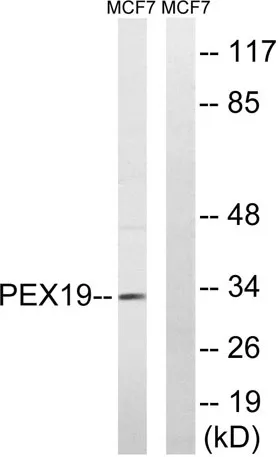Peroxin 19 rabbit pAb
CAT:
855-ES6950-02
Size:
100 μL
Price:
Ask
- Availability: 24/48H Stock Items & 2 to 6 Weeks non Stock Items.
- Dry Ice Shipment: No




Peroxin 19 rabbit pAb
- Description: Peroxisomal biogenesis factor 19 (PEX19) Homo sapiens This gene is necessary for early peroxisomal biogenesis. It acts both as a cytosolic chaperone and as an import receptor for peroxisomal membrane proteins (PMPs). Peroxins (PEXs) are proteins that are essential for the assembly of functional peroxisomes. The peroxisome biogenesis disorders (PBDs) are a group of genetically heterogeneous autosomal recessive, lethal diseases characterized by multiple defects in peroxisome function. These disorders have at least 14 complementation groups, with more than one phenotype being observed for some complementation groups. Although the clinical features of PBD patients vary, cells from all PBD patients exhibit a defect in the import of one or more classes of peroxisomal matrix proteins into the organelle. Defects in this gene are a cause of Zellweger syndrome (ZWS), as well as peroxisome biogenesis disorder complementation group 14 (PBD-CG14), which is
- Synonyms: PEX19; HK33; PXF; OK/SW-cl.22; Peroxisomal biogenesis factor 19; 33 kDa housekeeping protein; Peroxin-19; Peroxisomal farnesylated protein
- Gene ID: 5824
- UniProt: P40855
- Cellular Locus: Cytoplasm. Peroxisome membrane ; Lipid-anchor ; Cytoplasmic side. Mainly cytoplasmic. Some fraction membrane-associated to the outer surface of peroxisomes..
- Host: Rabbit
- Species Reactivity: Human, Rat, Mouse,
- Immunogen: The antiserum was produced against synthesized peptide derived from human PEX19. AA range:219-268
- Clonality: Polyclonal
- Validated Applications: WB, IHC, IF, ELISA
- Stability: 1 year
- Concentration: 1 mg/mL
- Dilution: Western Blot: 1/500 - 1/2000. Immunohistochemistry: 1/100 - 1/300. ELISA: 1/5000. Not yet tested in other applications.
- Molecular Weight: 33kD
- Storage Conditions: PBS with 0.02% sodium azide and 50% glycerol pH 7.4. Store at -20°C. Avoid repeated freeze-thaw cycles.
